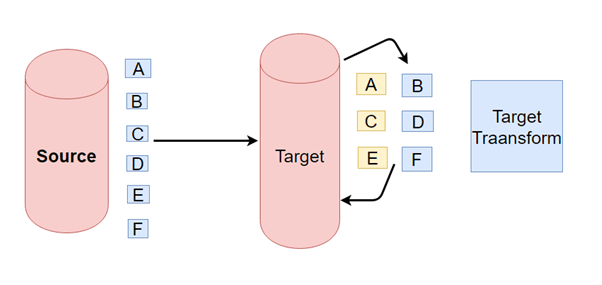ETL vs ELT – Difference Between Them
Key Difference between ETL and ELT
- ETL stands for Extract, Transform and Load, while ELT stands for Extract, Load, Transform.
- ETL loads data first into the staging server and then into the target system, whereas ELT loads data directly into the target system.
- ETL model is used for on-premises, relational and structured data, while ELT is used for scalable cloud structured and unstructured data sources.
- Comparing ELT vs. ETL, ETL is mainly used for a small amount of data, whereas ELT is used for large amounts of data.
- When we compare ETL versus ELT, ETL doesn’t provide data lake support, while ELT provides data lake support.
- Comparing ELT vs ETL, ETL is easy to implement, whereas ELT requires niche skills to implement and maintain.

What is ETL (Extract, Transform, Load)?
ETL is an abbreviation of Extract, Transform and Load. In this process, an ETL tool extracts the data from different RDBMS source systems then transforms the data like applying calculations, concatenations, etc. and then load the data into the Data Warehouse system.
In ETL data is flows from the source to the target. In ETL process transformation engine takes care of any data changes.

What Is ELT (Extract, Load, Transform)?
ELT is a different method of looking at the tool approach to data movement. Instead of transforming the data before it’s written, ELT lets the target system to do the transformation. The data first copied to the target and then transformed in place.
ELT usually used with no-Sql databases like Hadoop cluster, data appliance or cloud installation. Here’s a comprehensive list of some of the best ETL tools that you can consider for your data management needs.

ETL vs ELT: Side-by-Side Comparison
Following are the main ETL and ELT differences:
| Parameters | ETL | ELT |
|---|---|---|
| Process | Data is transformed at staging server and then transferred to Datawarehouse DB. | Data remains in the DB of the Datawarehouse.. |
| Code Usage | Used for
|
Used for High amounts of data |
| Transformation | Transformations are done in ETL server/staging area. | Transformations are performed in the target system |
| Time-Load | Data first loaded into staging and later loaded into target system. Time intensive. | Data loaded into target system only once. Faster. |
| Time-Transformation | ETL process needs to wait for transformation to complete. As data size grows, transformation time increases. | In ELT process, speed is never dependant on the size of the data. |
| Time- Maintenance | It needs highs maintenance as you need to select data to load and transform. | Low maintenance as data is always available. |
| Implementation Complexity | At an early stage, easier to implement. | To implement ELT process organization should have deep knowledge of tools and expert skills. |
| Support for Data warehouse | ETL model used for on-premises, relational and structured data. | Used in scalable cloud infrastructure which supports structured, unstructured data sources. |
| Data Lake Support | Does not support. | Allows use of Data lake with unstructured data. |
| Complexity | The ETL process loads only the important data, as identified at design time. | This process involves development from the output-backward and loading only relevant data. |
| Cost | High costs for small and medium businesses. | Low entry costs using online Software as a Service Platforms. |
| Lookups | In the ETL process, both facts and dimensions need to be available in staging area. | All data will be available because Extract and load occur in one single action. |
| Aggregations | Complexity increase with the additional amount of data in the dataset. | Power of the target platform can process significant amount of data quickly. |
| Calculations | Overwrites existing column or Need to append the dataset and push to the target platform. | Easily add the calculated column to the existing table. |
| Maturity | The process is used for over two decades. It is well documented and best practices easily available. | Relatively new concept and complex to implement. |
| Hardware | Most tools have unique hardware requirements that are expensive. | Being Saas hardware cost is not an issue. |
| Support for Unstructured Data | Mostly supports relational data | Support for unstructured data readily available. |
